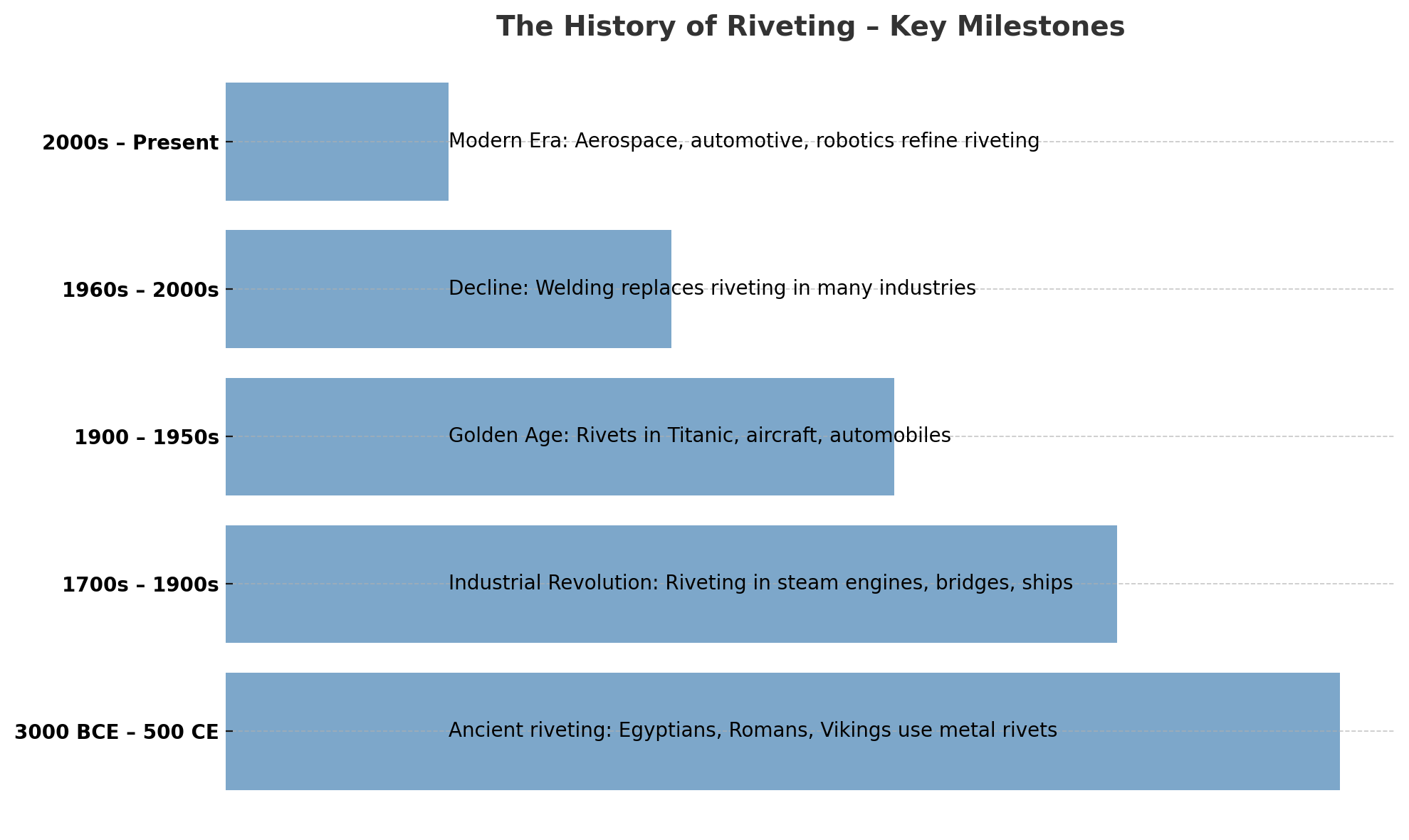Introduction
Riveting is one of the oldest and most reliable methods of fastening materials. From the construction of ancient chariots and medieval armor to modern aerospace technology, rivets have played a crucial role in human innovation.
This article explores the history of riveting, tracing its evolution from early civilizations to today’s high-tech industries.
Ancient Riveting – The Beginning of Metal Fastening (3000 BCE – 500 CE)
Early Metalwork and Riveting in Ancient Civilizations
The use of rivets dates back to the Bronze Age (around 3000 BCE) when early metalworkers needed a way to join metal plates.
Egyptians used copper rivets in tools and jewelry. Sumerians and Mesopotamians applied riveting techniques in metal armor. Greek and Roman civilizations used riveted joints in weapons, shields, and even warships like triremes.
Rivets in Early Construction and Weaponry
The Romans were among the first to use rivets in large-scale projects. Roman bridges, aqueducts, and armor plating were reinforced with rivets to provide structural integrity. Medieval blacksmiths used riveting in chainmail armor and siege engines. Viking longships (9th-11th century) combined wooden pegs and metal rivets for hull reinforcement.
The Rise of Riveting in the Industrial Age (1700s – 1900s)
The Industrial Revolution and the Need for Stronger Joints
With the rise of steam engines, railways, and iron structures, riveting became a crucial engineering technique.
Steam locomotive boilers were riveted to withstand high pressures. Shipbuilding transitioned to iron and steel rivets, replacing wooden fasteners. Infrastructure and bridges started incorporating riveted iron frameworks.
Famous Riveted Structures of the 19th Century
The Eiffel Tower (1889) – Designed by Gustave Eiffel, it was held together with 2.5 million rivets. The Brooklyn Bridge (1883) – One of the first bridges to use steel cables and riveted iron towers. Steam Locomotives – Riveted boilers and chassis ensured durability.
During this period, riveting was still manual, requiring workers to heat rivets and hammer them into place.

The Golden Age of Riveting – Early 20th Century (1900 – 1950s)
Riveting in Shipbuilding and Aviation
Titanic (1912) – Built with over 3 million rivets, though weaker iron rivets in some sections contributed to its tragic sinking. Aircraft Manufacturing (WWI & WWII) – The first metal aircraft, such as the Douglas DC-3 and Spitfire, relied on riveted aluminum skins. Automobile Industry – Early Ford Model T cars used riveted steel frames before welding became dominant.
The Shift from Hot Riveting to Cold Riveting
Traditional rivets required heating before installation. In the 1930s, pneumatic cold riveting replaced hot riveting in aircraft and automobiles.
By the 1950s, welding began replacing riveting due to its stronger, more seamless joints.
The Decline of Riveting and the Rise of Welding (1960s – 2000s)
Why Welding Replaced Riveting in Many Industries
Steel bridges and skyscrapers – Welding provided stronger, seamless connections. Automobile manufacturing – Spot welding became faster and cheaper. Pipelines and heavy machinery – Welded joints handled pressure better.
Where Riveting Still Remained Essential
Despite the rise of welding, riveting remains dominant in: Aerospace Engineering – Aircraft skins are still riveted due to weight concerns. Railways – Some riveted steel structures remain in use due to their durability. Historic Restoration – Bridges, ships, and buildings use traditional rivet techniques.
Some industries prefer rivets over welding due to their vibration resistance and structural flexibility.
Modern Riveting – Where It Stands Today (2000s – Present)
High-Tech Riveting in Aerospace & Automotive
Boeing 787 and Airbus A350 use millions of precision rivets. Self-piercing rivets (SPR) – Applied in modern aluminum car frames (e.g., Tesla and Jaguar). Composite materials in aviation require special riveted joints.
Robotics and Automation in Riveting
Automated rivet guns have replaced manual riveting in aerospace factories. Friction-stir riveting – A technique combining elements of friction welding and riveting. Laser-assisted riveting – Used in lightweight material assemblies.
Today, riveting is faster, more precise, and still irreplaceable in certain applications.
Riveting vs. Other Joining Techniques – Why It Still Matters
Even with welding, adhesives, and other bonding technologies, rivets remain important because they: Handle vibrations better than welded joints.
Work on materials that are difficult to weld (e.g., aluminum alloys).
Allow for easy disassembly and repairs.
Best YouTube Videos on Riveting
▶ Hot Riveting – How It Is Performed Today
▶ How Riveting Built the Modern World
Conclusion
Riveting has evolved from ancient metalworking to modern high-tech applications. While welding and adhesives have taken over in many industries, rivets remain indispensable in aerospace, automotive manufacturing, and historical restoration.
The next time you see a steel bridge, an aircraft, or even a classic car, remember that riveting played a key role in its construction.
Did you know ?
Millions of Rivets – Every One Counts in the Sky
A modern passenger aircraft, like the Boeing 747, contains around 3 million rivets. But here’s the catch Each rivet must be:
- made from the right material (often aluminum or titanium alloys),
- placed at a precise angle,
- and driven with exact force.
Why? Because a single poorly placed rivet can cause a microcrack.
And a microcrack… can lead to disaster. That’s why in aviation, riveting isn’t just joining — it’s a ritual of precision. Many aircraft riveters are even trained to work on just one specific part of the fuselage.
Because up in the sky, there’s no room for “almost right”.
Related Articles
Riveting vs. Welding – Which is Better?
How Modern Aircraft Are Built – The Role of Riveting (soon)
The Strongest Types of Rivets and Their Applications (soon)